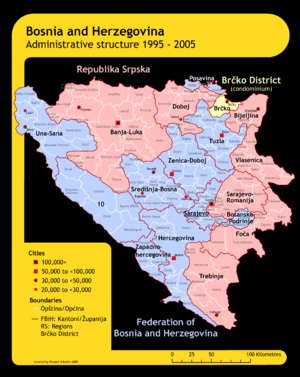Political divisions of Bosnia and Herzegovina

 |
| This article is part of a series on the politics and government of Bosnia and Herzegovina |
|
|
|
Politics portal |
The Dayton Accords had made the government type in Bosnia and Herzegovina that of international protectorate,[1] where foreigners via the Peace Implementation Council and High Representative exercise autocracy in overseeing an authoritarian democracy mainly for the elites representing three major ethnic groups. The regime has elements of hegemony by neighboring Croatia and Serbia as the co-signatories to the Dayton Accords.
The political divisions of Bosnia and Herzegovina were thus created by the Dayton Agreement, which recognized a second tier of government in Bosnia and Herzegovina, comprising two entities: the Federation of Bosnia and Herzegovina (FBiH), with mostly Bosniaks and Croats, and the Republika Srpska (RS) with mostly Serbs – each governing roughly one half of the state's territory. Today, all three ethnic groups have an equal constitutional status over the entire territory of Bosnia and Herzegovina.
Overview


The Federation and the RS governments are charged with overseeing internal functions. Each has its own government, flag and coat of arms, president, parliament (FBiH) and assembly (RS), police force & customs, and postal system. The police sectors are overseen by the state-level ministry of safety affairs. Since 2005, Bosnia and Herzegovina has one Armed forces.
Inter-entity borders are not determined on natural geographical features of the region. Its borders were postulated as part of the political agreement that was based on ethnic division and are used to determine the extents of political jurisdictions within entities. On the ground, there is no active border between RS and FBiH, and one would generally not know the difference when crossing from one entity into another.
The city of Brčko in northeastern Bosnia is a seat of the Brčko district, a self-governing administrative unit; it is part of both the Federation and Republika Srpska. The district remains under international supervision.
The Federation is further divided into cantons, which are then subdivided into municipalities. Republika Srpska is divided directly into municipalities.
Amendments to the divisions
On the grounds that the Dayton Agreement's framework is outdated, various interest groups have come forth with proposals for rearranging the divisions of Bosnia and Herzegovina. The Agreement was initially designed to effectively end the war in the nation, but the divisions have made the bureaucracy of the country unwieldy.
Generally speaking, the nation's Bosniak representatives wish for the state to be centralized, eliminating the Federation, as well as the Republika Srpska. Officials in the Republika Srpska vehemently resist this idea. Many Serbs assume that if Kosovo achieves independence, Republika Srpska will separate from Bosnia and Herzegovina, eventually joining Serbia. However, the Office of the High Representative has come out and specifically denied the prospect of any such territorial exchange. Representatives of the Bosnian Croats largely view the current situation as discriminatory, and seek either the abolition of entities and foundation of a decentralized governmental structure, or a third entity.
References
- ↑ John Bacher (2001) Review of "The Lessons of Yugoslavia" by Metta Spencer (Ed.) Elsevier Science, 2000, 378 pp. ISBN 0-7623-0280-1, Peace Magazine Jul-Sep 2001, p.28.
External links
- A precarious peace, The Economist, 22 January 1998
- The EU's pseudosuccess in Bosnia, Centre for Eastern Studies 2011
- Bosnia and Herzegovina: Ongoing erosion of the State, Centre for Eastern Studies 2011
| ||||||||||||||||||||||||||||||
| ||||||||||||||||||